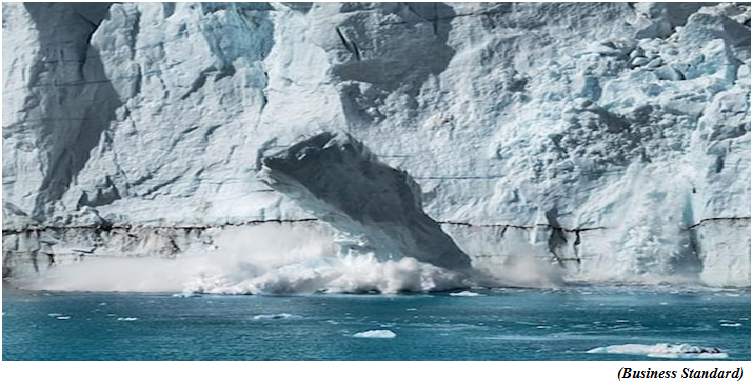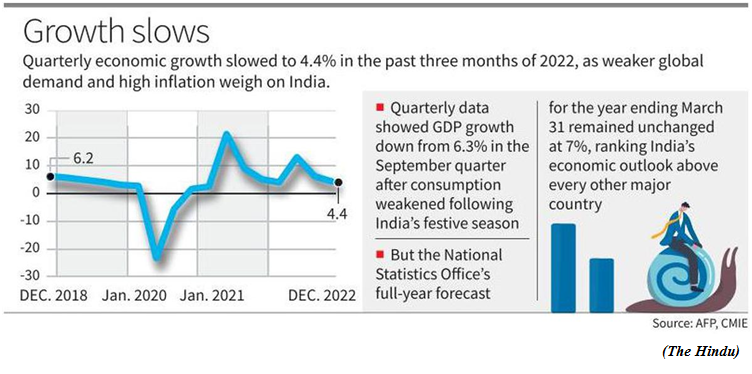Antarctic glaciers flow faster in summers show seasonal behaviour Study (GS Paper 3, Environment)

Why in news?
- Glaciers along Antarctica's coastline are flowing faster in the summer because of a combination of melting snow and warmer ocean waters, said researchers in a new study.
Details:
- On average, the glaciers, or giant blocks of moving ice, travel at around one kilometre a year.
- But the study has found a seasonal variation to the speed of the ice flow, which speeded up by up to 22 per cent in summer when temperatures are warmer.
- This gives an insight into the way climate change could affect the behaviour of glaciers and the role they could play in raising sea levels.
Antarctic Peninsula:
- The Antarctic Peninsula is the largest reservoir of frozen water on Earth.
- It is estimated that between 1992 and 2017, melt water from the glaciers increased global sea levels by around 7.6 mm.How that may change in the future is one of the big uncertainties in modelling climate change.
- The Antarctic Peninsula is the most northern and warmest region of Antarctica. It has a 1,000 km long mountainous spine, similar to the length of the east coast of Great Britain, and home to a rich marine ecosystem of seals, penguins and whales.
- Along the west coast of the peninsula, the glaciers drain ice from the ice sheet directly into the Southern Ocean.
How the study was conducted?
- Ateam of researchers, led by scientists at the University of Leeds, has used more than 10,000 satellite images, taken above the Antarctic Peninsula between 2014 and 2021, to understand how the flow of glaciers into the waters around the Antarctic alters during colder and warmer periods.
Key findings:
- Analysis of the satellite data showed that the glacier speed-up occurs in summer as snow melts and the temperature of the waters in the Southern Ocean rise.
- It is thought that water from the melting snow acts as a lubricant between the ice sheet and the underlying rock. As a result, friction is reduced and the speed at which the glaciers slide increases.
- In addition, the warmer waters of the Southern Ocean erode the front of the moving ice, which reduces the buttressing forces it exerts to resist the ice flow.
Way Forward:
- The Antarctic Peninsula has seen some of the most rapid warming of any region on Earth.
- Continuing work like this will help glaciologists monitor how quickly change is occurring, enabling accurate assessments of how Earth's ice will respond to climate change.
On regulating online sale of drugs in India
(GS Paper 2, Governance)
Why in news?
- In early February, the Ministry of Healthpulled up at least twenty companies including Tata-1mg, Flipkart, Apollo, PharmEasy, Amazon and Reliance Netmeds, by issuing them a showcause notice, for selling medicines online.
- This happened after the All India Organisation of Chemists and Druggists (AIOCD), a powerful lobby of over 12 lakh pharmacists, threatened to launch a country-wide agitation if the government didn’t act.

Is banning e-pharmacies a viable option?
- The Ministry of Health has adopted a ‘blow hot blow cold’ approach towards online pharmacies. The acute need for door step delivery of drugs was felt during COVID-19.
- The year of 2020 marked a watershed moment for the growth of e-pharmacies as the Ministry of Home Affairs issued orders for them to continue to operate. It saw nearly 8.8 million households using home delivery services during lockdown.
- The draft e-pharmacy rules, which were originally intended to whip e-pharmacy businesses into shape were floated by the Ministry of Health in 2018. The rules were finalised, public comments were taken into consideration and they were almost on the brink of being notified. But the proposal was abruptly shoved into cold storage.
- Since then, multiple court orders including those from Bombay, Madras, Delhi and Patna High Court have called for regulating e-pharmacies.
- The latest in the line is the 172nd Parliamentary Standing Committee report released in June 2022, which found it ‘appalling,’ that e-pharmacy rules had not been notified even after four years of the draft being introduced.
How are e-pharmacies competing with mom-and-pop chemist shops?
- Flush with billions of dollars of private equity money to infuse, e-pharmacies made a bang in the market in 2015 and started offering hefty discounts on medicines in a bid to garner more market share. But they didn't just stop at the discounts.
- E-pharmacies call themselves facilitators of doorstep delivery. They claim tie-ups with retail chemists for vending medicines. However, since profit margins in the drug retail industry are very thin, just about 15% to 16%, every player in the supply chain is struggling to make money.
What’s next?
- Both e-pharmacies and offline retail pharmacists have realised that in a climate where drug delivery is driven by consumer sentiments, it is futile to stick to any one way of doing business.
- For acute care and emergency, patients still rely on their neighbourhood pharmacy stores.
- This has led e-pharmacy players to now open capital-intensive brick and mortar stores. Until March 2021, Reliance had opened 114 pharmacies inside their Smartpoint grocery stores. It plans to open 2,000 more outlets. Apollo Pharmacy which has nearly 4,000 physical stores also caters to online sales.
- Stiff competition has forced mom and pop pharmacists to also offer home delivery options to their customers by introducing their own store apps.
- In an eco-system that is moving towards a hybrid mode, all eyes are on the Ministry of Health which will have to effectively regulate the new way of doing e-commerce in the drug space.
Q3 GDP growth slows to 4.4%, past data upgraded
(GS Paper 3, Economy)
Why in news?
- India’s GDP growth slowed to 4.4% in the October-December 2022 quarter, from 6.3% in the second quarter (Q2) of 2022-23 as per the National Statistical Office (NSO), which retained its full-year growth estimate for the economy at 7%, despite revising the preceding fiscal’s GDP growth figure 40 basis points higher to 9.1%.

Key Highlights:
- The NSO revised the GDP contraction numbers for the COVID-hit year of 2020-21, pegging the overall hit to the economy that year at -5.7% as per Second Revised Estimates, significantly narrower than its first provisional estimate of a 7.3% contraction.
- The Gross Value Added (GVA) in the economy grew 4.6% in the third quarter (Q3) of 2022-23, slower than 5.5% in Q2.
- Manufacturing continued to shrink for the second quarter, albeit at a slower pace of 1.1% compared with Q2’s 3.6% contraction.
Why growth slowed down?
- Economists termed the manufacturing sector’s persistent slack a negative surprise that brought Q3 growth levels lower than their projections.
- The 4.4% GDP growth print is also because of the revisions made to the previous years when the base has gone up.
Future projections:
- The NSO had persisted with the 7% growth hopes for 2023 as projected in early January, implied that GDP growth would improve to 5.1% in the ongoing final quarter of the year, which was higher than “current expectations”.
- The CEA pointed out that even if the 4.4% growth rate of Q3 persisted in the January-March period (Q4), the full-year growth rate would still be about 6.8%.
- Cumulatively, the first nine months of 2022-23 have now reported a GVA uptick of 7.2% compared with 10.7% in the same period of 2021-22, while GDP is estimated to have risen 7.7% compared with 11.1% in April to December 2021.
Sharp revisions:
- Following the data revisions for the past two years, the cumulated average real GDP growth rate over the period 2019-20 to 2022-23 is 3.2%.
- Overall GVA growth in Q1 has been revised lower from the 12.7% reckoned earlier to 12.1%, while the Q2 GVA uptick has been pared marginally from 5.6% estimated earlier to 5.5%. GDP growth for the first quarter of 2022-23 has been revised down to 13.2% from 13.5% estimated earlier, but Q2 GDP growth estimates have been left unchanged.
- Manufacturing and Mining GVA contractions for Q2 have been upgraded by the NSO from its earlier estimates of a 4.3% and 2.8% shrinkage in the two sectors, respectively.
- Agriculture GVA growth, on the other hand, has been downgraded sharply for Q1 as well as Q2. The Q3 Mining and quarrying GVA recovered from a 0.4% contraction in Q2 to grow 3.7% in Q3, while Agriculture, Forestry and Fishing GVA accelerated to 3.7%, the fastest pace of growth in 2023.
Conclusion:
- The CARE Ratings expressed greater concern about the fall in India’s investment to GDP ratio to around 32 in Q3 from 34 in Q2, and said it is critical that domestic demand should accelerate in the months ahead as external demand conditions remain weak.




